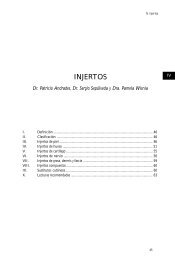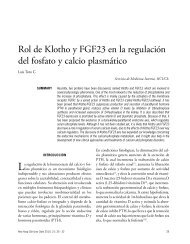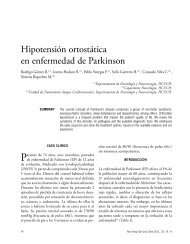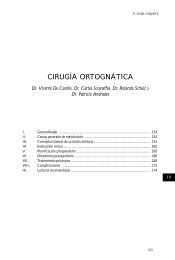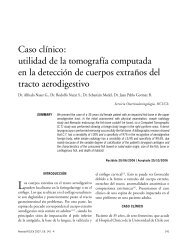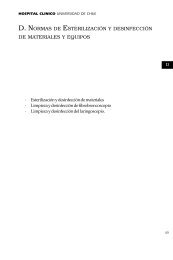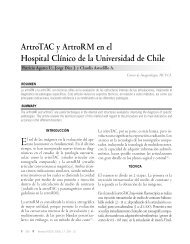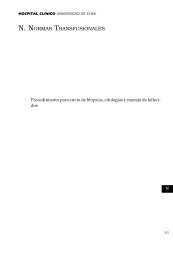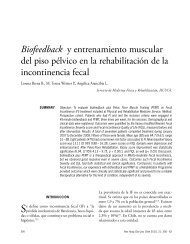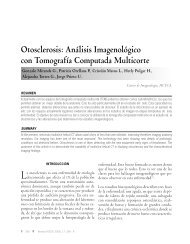Abstracts de trabajos presentados en congresos internacionales 2012
Abstracts de trabajos presentados en congresos internacionales 2012
Abstracts de trabajos presentados en congresos internacionales 2012
You also want an ePaper? Increase the reach of your titles
YUMPU automatically turns print PDFs into web optimized ePapers that Google loves.
female. Intestinal motility was assessed by perfused catheters and external transducers with standardized technique during 309± 47 minutes and 279 ± 49 minutes in pati<strong>en</strong>ts and healthy subjects, respectively. The cyclic activity (CA), duration of MMC,duration of MMC’s phases, amplitu<strong>de</strong> and frequ<strong>en</strong>cy of contractions in phase II and III, intestinal motility score (IMS) and clusteredcontractions were evaluated. The referral for consultation was chronic diarrhea in 10 pati<strong>en</strong>ts, constipation in 4, abdominal pain in3, gastroesophageal reflux in 3, intestinal pseudoobstruction in 3 and 2 pati<strong>en</strong>ts with gastric ret<strong>en</strong>tion syndrome. History of totalor partial gastrectomy plus vagotomy was found in 12 pati<strong>en</strong>ts. Statistical analysis was assessed using t-test and Kruskal-Wallis.Results: From the pati<strong>en</strong>ts group, 9 did not showed a phase III during the <strong>en</strong>tire study, whereas all from the control group hadcyclical activity. The pres<strong>en</strong>ce of clustered contractions was pathological (> 4 per hour) in 4 pati<strong>en</strong>ts and none in the control group(0.036). There were no differ<strong>en</strong>ces betwe<strong>en</strong> gastrectomized and non gastromized pati<strong>en</strong>ts. Conclusion: Vagotomized pati<strong>en</strong>tswith digestive symptoms show severe small intestinal motor disor<strong>de</strong>rs. The most frequ<strong>en</strong>t symptom after vagotomy was chronicdiarrhea. The pres<strong>en</strong>ce of gastrectomy did not increase the severity of the intestinal motor disor<strong>de</strong>r. The abs<strong>en</strong>ce of cyclical activityfound in almost one third of the pati<strong>en</strong>ts and the differ<strong>en</strong>ces in intestinal motility, suggest a neuropathic pattern. However, studieswith a greater number of pati<strong>en</strong>ts are nee<strong>de</strong>d.XXXI WORLD CONGRESS OF INTERNAL MEDICINE – SANTIAGO, CHILECARCINOID NEUROENDOCRINE TUMOR TREATMENT WITH RADIONUCLIDES. CASE REPORT.R. Collado, J. Carmona, P. Zhindon, P. González.Introduction: Neuro<strong>en</strong>docrine tumors (NETs) gastro<strong>en</strong>teropancreatic repres<strong>en</strong>t about 2% of all gastrointestinal tumors. It hasan inci<strong>de</strong>nce of 2.5-5 cases per 100,000 per year. The term carcinoid refers to tumors that originate in ileal <strong>en</strong>terochromaffincells produce serotonin which have better prognosis than a<strong>de</strong>nocarcinomas. Description: Male pati<strong>en</strong>t, 55 years old. History ofhypert<strong>en</strong>sion treatm<strong>en</strong>t. Mother dies of intestinal NET. During routine monitoring is performed r<strong>en</strong>al Doppler ultrasound scanwhere hepatic nodule scre<strong>en</strong>ing solid hypervascularized right. MRI is requested and displayed multiple hypervascular liver lesions,suggestive of secondary lesions. During gastro<strong>en</strong>terology Control refers colicky abdominal pain, diarrhea without pathologicalelem<strong>en</strong>ts and episo<strong>de</strong>s of flushing objectified during the interview. Discussion: It is proposed as a likely diagnosis NET carcinoidwith liver metastases and carcinoid syndrome. Requested PET/CT 68Ga which conclu<strong>de</strong>s as primary carcinoid tumor of small bowelloop, possibly ileum, mes<strong>en</strong>teric and hepatic secondary locations. A year later he performed echocardiography in highlightingmild pulmonary hypert<strong>en</strong>sion, tricuspid reflux mild and mo<strong>de</strong>rate pulmonary reflux with good LV systolic function. Again requestedPET/CT 68Ga which highlights frank progression from prior examination also adding another commitm<strong>en</strong>t to small bowel loop inthe right iliac fossa. The pati<strong>en</strong>t repeatedly refuses to un<strong>de</strong>rgo surgery or biopsy and Nuclear Medicine is <strong>de</strong>rived which <strong>de</strong>ci<strong>de</strong>ssequ<strong>en</strong>tial therapy with radionucli<strong>de</strong>s. After 3 sessions, we conclu<strong>de</strong> from the systemic tracking of each meeting, that: no evi<strong>de</strong>nceof disease progression with a partial response and <strong>de</strong>creased tumor tissue somatostatin receptor positive, and no evi<strong>de</strong>nce ofspread to other locations (not there is uptake in the chest or heart area which is ruled by metastases in this area and <strong>en</strong>docardialdamage would be giv<strong>en</strong> by mediators). During last session is requested echocardiography (7 months after the first) that displaysand nonspecific diffuse involvem<strong>en</strong>t of predominantly right valve with mo<strong>de</strong>rate pulmonary regurgitation, mild tricuspid st<strong>en</strong>osisand severe insuffici<strong>en</strong>cy, severe dilated right atrium and inferior v<strong>en</strong>a cava, septal hypertrophy mild, mild dilation of aortic root andright atrium with preserved LV systolic function, which does not correlate with the relative good functionality of the pati<strong>en</strong>t. Thiscase illustrates that in NET radionucli<strong>de</strong> therapy is effective in <strong>de</strong>creasing the progression of disease, and also <strong>de</strong>monstrates therapid and severe <strong>en</strong>docardial commitm<strong>en</strong>t typical of advanced stages of this disor<strong>de</strong>r.LEFT MAIN CORONARY TRUNK ORIGINATED IN PULMONARY ARTERY IN AN ADULT. CASE REPORT.H. Ugal<strong>de</strong>, M Muñoz, D. Ugal<strong>de</strong>, S. García, E. FariasIntroduction: Coronary arteries origin anomalies are <strong>de</strong>tected in 0.5 – 1.5% of all angiographies; in Chile the most frequ<strong>en</strong>t isanomalous origin of right coronary artery from left coronary sinus. Anomalous origin of the left main trunk is the most rareand its origin from pulmonary artery in adults is exceptional, usually because it’s not compatible with reaching adult age.This is the first reported case of this anomaly in an adult pati<strong>en</strong>t in our country. Description: An 49 years old female, chronicsmoker, dislipi<strong>de</strong>mic, that pres<strong>en</strong>ted with 2 months history of typical non progressive angina. The physical exam was normalas electrocardiography and echocardiography, exercise electrocardiogram suggested ischemia. Reinterrogation revealedmo<strong>de</strong>rated efforts dyspnea from young age without any study. Coronary angiography was performed, it showed abs<strong>en</strong>ce ofthe left main trunk in the left coronary sinus, dilated right coronary artery, with no lesions and ext<strong>en</strong>sive collateral circulation toanterior <strong>de</strong>sc<strong>en</strong>ding and circumflex arteries, with inverted flow left main trunk draining to the pulmonary artery. Left v<strong>en</strong>triclewas mildly dilated with middle and apical anterior hypokinesia, global systolic function was conserved. Surgical correction was70Revista Hospital Clínico Universidad <strong>de</strong> Chile




